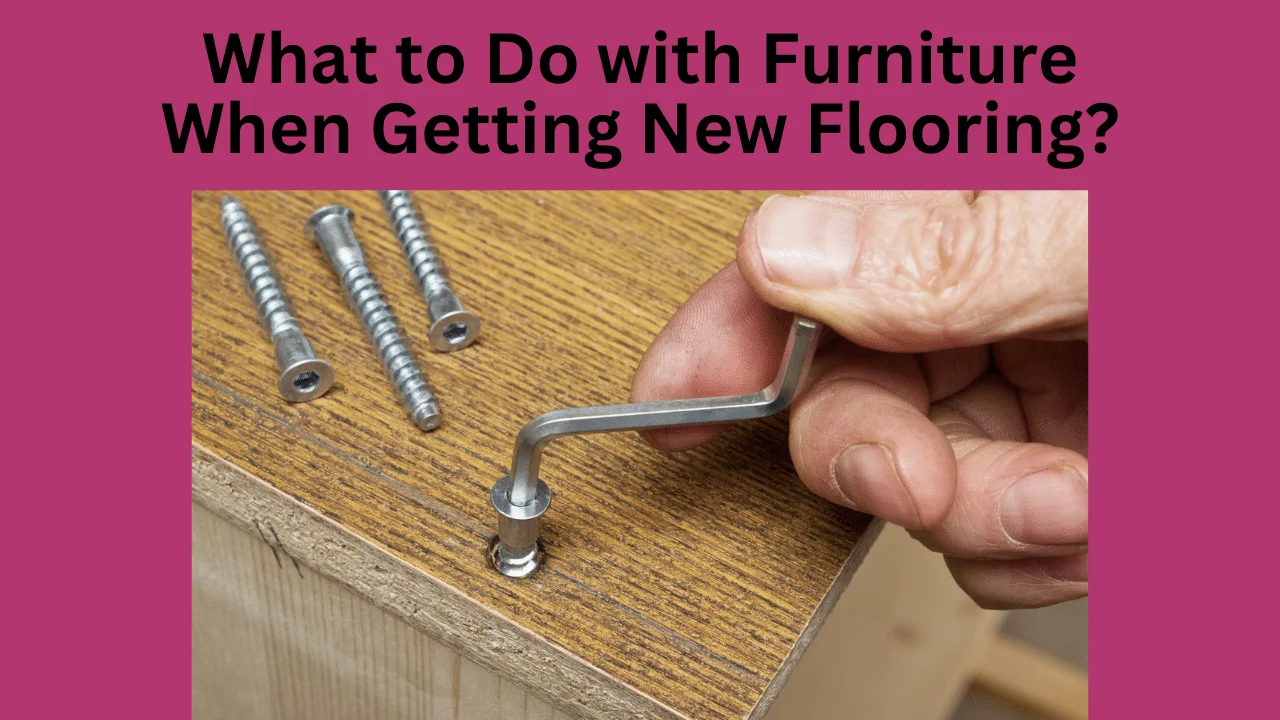Introduction
Incorporating new flooring into your home can be a thrilling endeavor that completely transforms the aesthetic of your area. But choosing a new home for your furniture is a major obstacle in this process. “What to Do with Furniture When Getting New Flooring?” is a question many homeowners face. To keep your possessions undamaged and the installation process running smoothly, it is crucial to carefully arrange your furniture before beginning the flooring project.
Purpose of this Article
Anyone planning to have new flooring installed and isn’t sure what to do with their furniture during the process will find helpful information in this article. Whether you’re doing the installation yourself or bringing in the pros, these pointers will keep your furniture safe and make the process go smoothly.
Assessing Furniture Needs
Furniture Volume
Make sure you have a complete list of all the furniture in the room that will be impacted by the new flooring before you start. Big pieces like beds, couches, and dining tables and little ones like end tables, chairs, and lamps are all part of this category. The greatest way to handle furniture during flooring installation depends on knowing their volume and type.
Identifying Sensitive Items
Antiques, fragile wood furniture, and upholstered pieces are examples of furniture that is especially vulnerable to damage from motion and other environmental factors. These items might need to be stored in a controlled environment or given extra protection when being moved.
Furniture Storage Options
Choose between relocating the furniture to a different room, storing it somewhere else, or keeping it in the same room with proper covering. You should weigh the benefits and drawbacks of each option and make a final decision based on your flooring project timeline, available space, and budget.
Professional Movers
Hiring professional movers could be the way to go if you have a lot of big furniture pieces or other bulky items. Furniture and your home are less likely to sustain damage when you hire movers because of their training and specialized equipment for handling heavy and fragile objects.
Using Furniture Sliders
Furniture sliders are useful for do-it-yourself projects. Put these little pieces of cloth or plastic under the legs of heavy furniture to cushion the move and protect your floors from damage.
Preparing Furniture for New Flooring Installation
Cleaning and Inspecting Furniture
Take the time to clean and examine each piece of furniture before you move it. Because dust and debris can damage surfaces, regular cleaning is required. You can find any pre-existing damage to your furniture that you may wish to fix before or after installing the flooring by inspecting it.
Disassembling Large Items
It is safer and easier to disassemble bigger pieces of furniture before moving them. Disassemble modular sofas by removing their legs and any other detachable components. To facilitate easy reassembly, label bags and store screws and small components inside.
Covering and Protecting Furniture
Wrap each piece of furniture in plastic or a moving blanket if you must leave it in the same room while the flooring is being installed. Protecting your furniture from installation-related dust, debris, and harm is our top priority.
Organizing Smaller Items
Put delicate things like lamps, decorations, and electronics in their own boxes and transfer them separately. To keep breakables safe, wrap them in bubble wrap and store them in strong boxes. Once the new flooring is installed, unpacking and reorganizing will be a breeze if you clearly label each box.
Planning for Temporary Storage
Before relocating or storing furniture elsewhere, make sure the new location is safe, dry, and clean. To keep delicate items safe from changes in humidity and temperature while they are stored off-site, think about utilizing a climate-controlled facility.
Moving Furniture for Flooring Installation
Creating a Moving Plan
Moving furniture can be a hassle if you don’t have a plan. Lay out your strategy for moving objects, beginning with the biggest and heaviest ones. By following this strategy, you can make sure that there is ample room to move around and easily place smaller items.
Using Furniture Sliders Effectively
If you need to move heavy furniture a short distance, a furniture slider is your best bet. Slide a piece of furniture across the floor by placing one under each leg or corner and gently pushing or pulling. Using this method, you can lessen the likelihood of damaging your flooring with scratches and dents.
Hiring Professional Moving Services
It may be worth it to hire professional movers if you have a lot of heavy or valuable belongings to transport or if your move is lengthy. Professional movers have the know-how and tools to safely move any kind of furniture. Additionally, they can offer insurance coverage to protect against any unintentional harm.
Ensuring Safety During the Move
When moving furniture, make sure everyone’s safety is your first concern. When lifting large or heavy objects, make sure to wear sturdy shoes, follow proper lifting techniques, and ask for assistance if needed. To avoid tripping and falling while relocating, make sure all walkways are clear of obstacles.
Storing Furniture Temporarily
Think about getting some short-term storage for your furniture if you expect your flooring project to take a few days or weeks. Until the job is finished, you can have portable storage containers brought to your house, filled up whenever it’s convenient for you, and then stored at a safe facility.
Protecting Furniture During Flooring Installation
Using Protective Covers
After you move your furniture to a safer spot, cover it to prevent dust and debris from getting on it. For the duration of the flooring installation, you can get by with just using plastic sheets, moving blankets, or furniture covers as protection.
Setting Up Barriers
To contain the dust and debris from the job site and keep it from spreading throughout your home, set up barriers around it. To prevent dust and debris from spreading throughout your home, you can use painter’s tape and plastic sheeting to block off any entrances or exits.
Maintaining a Clean Work Environment
Keep the work area clean at all times while installing the flooring to avoid the buildup of dust and debris. By following this practice, you can safeguard your furniture and enjoy a more seamless installation with an improved end result.
Monitoring Environmental Conditions
While you are installing flooring in your home, be sure to monitor the weather. Make sure the room is dry and the temperature is within the range that the new flooring and furniture are designed to withstand. Some materials are more vulnerable to the effects of extreme weather, such as warping and cracking.
Waiting for the Flooring to Cure
You should wait until the new flooring has dried completely before rearranging your furniture on it. To avoid damaging the new flooring, be sure to follow the manufacturer’s curing time recommendations.
Furniture After Flooring Installation
Cleaning New Flooring
Make sure the new flooring is completely clean before rearranging the room’s furniture. For a spotless finish, sweep away any dust, dirt, or adhesive residue. Avoid damaging your flooring by using the cleaning products recommended by the manufacturer.
Reassembling Disassembled Items
When you get home from moving, put back together any pieces of furniture that were disassembled. Before reassembling, check the parts and screws for their corresponding labels to make sure everything is in its proper place.
Positioning Furniture Carefully
To protect your new flooring from scratches and dents, place felt pads or furniture coasters under the legs of your furniture before placing them on it. Make the most of the room’s aesthetic potential and practicality by carefully arranging the furniture.
Evaluating Furniture Placement
This is a great chance to rearrange your furniture. To achieve a harmonious and aesthetically pleasing space, think about the room’s flow, the lighting, and the focal points. Changing things up could make your home seem better than before.
Inspecting for Any Damage
Check every piece of furniture for damage that may have happened during the move after you’ve put it back in its original location. Take care of any problems as soon as possible to keep your furniture in excellent condition.
Storing Furniture During New Flooring Installation
Using Climate-Controlled Storage Units
If you need to store delicate furniture while having flooring installed, a climate-controlled storage unit is a great option. Furniture made of wood, fabric, or leather is protected from mold, warping, and cracking by these units’ constant humidity and temperature levels. This is of utmost importance when it comes to sentimental items and antique furniture.
Renting Portable Storage Containers
If you need somewhere to put things temporarily, consider renting some portable storage containers. The containers will be sent to your house, and you can fill them up whenever you choose. Once they are packed, they are collected and kept at a safe location. With this method, you can access your belongings whenever you want, without having to make numerous trips to the storage unit.
Utilizing Unused Rooms
For short-term storage, consider using a spare bedroom, basement, or other unfinished area of your home. Make sure there are no bugs or moisture problems in the storage area. To avoid scratches and other damage to the floors during the move, cover them with moving blankets or cardboard.
Protecting Furniture from Damage
Wrapping Furniture in Protective Materials
To ensure that your furniture remains undamaged during the flooring installation, it is essential to wrap it in protective materials. Be sure to completely cover each piece of furniture with a blanket, some bubble wrap, or plastic sheeting. Tape the wrapping to ensure it stays put and shields the item from physical impacts, dust, and debris.
Elevating Furniture Off the Floor
To prevent dust and debris from getting on any furniture that needs to stay in the room during the installation, make sure to lift it off the floor. For a little extra support, prop up the furniture with some bricks, blocks, or strong wood. As an added bonus, this makes vacuuming under and around the furniture much simpler while it’s in place.
Using Protective Corners and Pads
The legs and corners of furniture are especially prone to harm when being moved. To protect these areas, use felt pads and corner protectors. Felt pads make it easy to move furniture around without scratching or denting the floors, and corner protectors keep furniture from getting dents and scratches.
Planning and Coordination
Scheduling the Flooring Installation
To keep things as smooth as possible, plan the flooring installation ahead of time. Pick a time when you won’t be interrupted and can focus on getting your furniture ready to move. The best time to schedule the project is when you will have some time off work or other obligations so that you can give your full attention to it.
Coordinating with Flooring Installers
Coordinate the project schedule by talking to the flooring installers. Ask for their advice on how to best prepare and protect your furniture, and let them know when you’ll need to move it. Making sure you and the installers understand each other and can communicate effectively is essential for efficient work.
Setting Up a Temporary Living Space
Create a makeshift living quarters in another area of your house in case the flooring project impacts a main living area. Create a relaxing and practical space where you can do your daily tasks without much interference by relocating important furniture and belongings here.
Maintaining the New Flooring
Waiting for the Floor to Cure
Make sure the new flooring has enough time to cure after installation before rearranging the furniture. Be sure to follow the manufacturer’s recommendations regarding the flooring’s curing time, as it can vary. If you try to move too quickly, you might ruin the floor or leave unsightly furniture imprints that are hard to remove.
Using Protective Pads and Rugs
Protect your brand-new flooring from wear and tear by placing felt pads under furniture legs and rugs in heavily walked-on areas. Scratches and dents can be avoided with felt pads, and rugs can significantly lessen wear and tear. Heavy furniture can quickly ruin floors made of hardwood, laminate, or vinyl, so this is of the utmost importance.
Regular Cleaning and Maintenance
Maintaining your new flooring on a regular basis will ensure that it looks great and lasts a long time. For the best results, use cleaning products and methods as directed by the manufacturer. You should stay away from abrasive tools and chemicals because they can ruin the floor’s finish. If you sweep, mop, and vacuum your floors regularly, they will retain their pristine appearance for many years.
Long-Term Furniture Management
Periodic Furniture Rotation
To keep your floors from wearing out too quickly, try rotating your furniture every so often. Uneven fading and indentation marks can be avoided by following this procedure. To make sure your flooring wears evenly and lasts longer, rotate heavy items like sofas and beds every few months.
Investing in Furniture Upgrades
Now that your new flooring is set up, you might want to think about getting some new furniture. Find furniture that goes well with the color and design of your new flooring. Enhance the overall look and feel of your home by investing in high-quality furniture that matches your flooring. This will create a cohesive and stylish environment.
Safety and Precautions
Using Proper Lifting Techniques
To avoid injury, always use proper lifting techniques when moving furniture. Lift with your legs instead of your back by bending at the knees while keeping your back straight. Seek assistance or make use of moving tools like dollies and sliders if the object is awkward or heavy to lift on your own.
Securing Furniture During Transport
Be cautious when loading and transporting furniture to a storage facility off-site. Keep your belongings from moving around while in transport by using moving straps and tie-downs. You can avoid damage and have a worry-free move if you secure your furniture correctly.
Handling Fragile Items with Care
When moving fragile items, be extra careful. Be careful to wrap and cushion fragile items well, and mark boxes with fragile items clearly. Use care when handling these items, and don’t put anything heavy on top of them.
Frequently Asked Questions
How to Prepare a Room for New Flooring Installation
Preparing a room for new flooring involves moving furniture, cleaning the space, and covering items that can’t be moved. Follow the steps outlined in this article for a smooth and successful flooring installation.
Best Ways to Move Furniture for New Flooring
Using furniture sliders, disassembling large items, and hiring professional movers are some of the best ways to move furniture for new flooring. Each method has its benefits, and the best choice depends on your specific needs and resources.
What to Do with Large Furniture When Replacing Flooring
Large furniture can be moved to another room, stored off-site, or covered and left in place during the flooring installation. Consider the size, weight, and sensitivity of each piece when deciding the best approach.
Can You Install New Flooring with Furniture in the Room?
While it’s possible to install new flooring with furniture in the room, it’s not recommended. Moving or covering the furniture ensures a cleaner and more efficient installation process and prevents damage to your belongings.
Temporary Storage Solutions for Furniture During Flooring Projects
Temporary storage solutions include portable storage containers, climate-controlled storage facilities, and using other rooms in your home. Choose the option that best fits your needs, budget, and the duration of your flooring project.
Conclusion
Protecting your possessions and achieving a successful conclusion to a flooring installation project depend on your ability to manage your furniture effectively. “What to Do with Furniture When Getting New Flooring?” is a crucial question to address. You can get a gorgeous new floor without ruining your beloved belongings if you take the time to measure your furniture, move it carefully, and cover it during the installation. If you follow these expert tips, you should be able to complete the process with ease and confidence.

Shannon Reyes is a seasoned writer with a knack for crafting engaging blogs on a variety of service industries, including plumbing, cleansing, moving, pest control, and roofing. With a keen eye for detail and a passion for helping readers navigate complex topics, Shannon brings her expertise to life through informative and accessible content.










